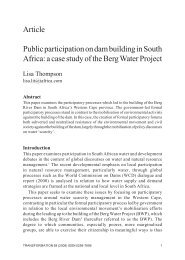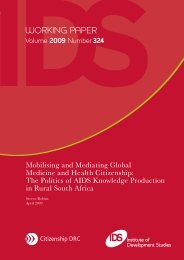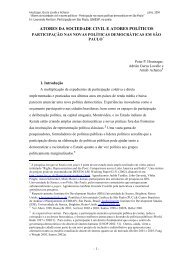Associations and the Exercise of Democratic ... - Citizenship DRC
Associations and the Exercise of Democratic ... - Citizenship DRC
Associations and the Exercise of Democratic ... - Citizenship DRC
Create successful ePaper yourself
Turn your PDF publications into a flip-book with our unique Google optimized e-Paper software.
IDS WORKING PAPER 285Research on <strong>the</strong> micro-political impact <strong>of</strong> associations on democracy makes avariety <strong>of</strong> distinctions between types associations, but only one is relevant here. 24For both analytic <strong>and</strong> empirical reasons, <strong>the</strong> nature <strong>of</strong> <strong>the</strong> relationship betweenindividuals <strong>and</strong> associations – formal membership or active participation – isimportant. Formal membership is only one <strong>of</strong> various types <strong>of</strong> relations people mayhave to an association that can impact citizenship. Here, <strong>the</strong> associational effectson citizenship are believed to accrue from face-to-face interaction <strong>and</strong> o<strong>the</strong>rsocial network effects that make possible <strong>the</strong> acquisition <strong>of</strong> civic skills, values, <strong>and</strong>information, ra<strong>the</strong>r than membership status (Putnam 2000: 58; Skocpol 1999:498–504). However, <strong>the</strong> convention in survey research conducted in affluentwestern democracies, <strong>and</strong> transported to o<strong>the</strong>r contexts, has been to use formalmembership as a proxy for associational activity. In analytic terms, a person whoperiodically is active in a civil society association, but is not a member <strong>of</strong> thatassociation, is more likely to acquire <strong>the</strong> skills, information <strong>and</strong> social networkbenefits that come from associational practices than <strong>the</strong> individual who has formalmembership but only makes an annual financial contribution to an organisation.Counting people whose sole membership activity is making financial contributionsas being associational active is to ignore <strong>the</strong> core elements <strong>of</strong> associational activitythat <strong>the</strong>orists suggest make it an important component <strong>of</strong> democracy.Fur<strong>the</strong>rmore, empirically, associations in São Paulo <strong>and</strong> Mexico City are more likelyto define such relations in terms <strong>of</strong> a ‘community’ ra<strong>the</strong>r than individual members(Gurza Lavalle et al. 2005a: 954). 25For <strong>the</strong>se reasons, instead <strong>of</strong> using membership in associations, we use a simple set<strong>of</strong> dichotomous variables for participation in <strong>the</strong> activities <strong>of</strong> associations. 26 Thiscasts a wider net that fits empirical realities <strong>of</strong> <strong>the</strong> region in which <strong>the</strong> survey wasconducted <strong>and</strong> captures <strong>the</strong> core analytic dimensions <strong>of</strong> participation in <strong>the</strong>literature. There is one exception: we use formal membership in <strong>the</strong> case <strong>of</strong>workplace organisations such as trade unions <strong>and</strong> pr<strong>of</strong>essional associations.Most survey research in Latin America asks respondents about <strong>the</strong>ir currentmembership in associations, or fails to specify <strong>the</strong> time period. We use a five yeartime window. If an individual has participated in <strong>the</strong> activities <strong>of</strong> association in <strong>the</strong>five years prior to <strong>the</strong> interview, (s)he is likely to still possess many, if not all, <strong>of</strong> <strong>the</strong>benefits that may accrue from participation – information, knowledge, skills, etc.24 Distinctions include those between internally democratic <strong>and</strong> autocratic associations(Putnam 1993; Cohen <strong>and</strong> Rogers 1995), purposefully political <strong>and</strong> non-political (Skocpol1999; Diamond 1999), <strong>and</strong> formalised forms <strong>of</strong> bonding or bridging social capital (Putnam2000; Hill <strong>and</strong> Matsubayashi 2005). For an overview, see Fung (2003).25 The same appears to be true in Delhi, India (Harriss 2005). In <strong>the</strong> particular case <strong>of</strong>participation in religious groups, <strong>the</strong> st<strong>and</strong>ard question – ‘are you a member <strong>of</strong> a religiousgroup' – is inadequate for predominantly Catholic countries. Such phrasing is contextspecific to countries where Protestant churches are most common. The Catholic Church isorganised in a way, <strong>and</strong> around a set <strong>of</strong> beliefs, that leaves <strong>the</strong> notion <strong>of</strong> ‘membership’without cultural resonance <strong>and</strong> as a result, active participation in religious groups will beunderreported.26 Studies most <strong>of</strong>ten ask a closed question on current membership in a range <strong>of</strong> associationswhich are listed one by one. This approach is thought to provide higher response rates thanopen questions that are later coded. Cf. IBGE (1988 <strong>and</strong> 1996), SEADE (1998).22





